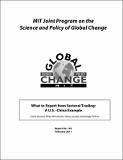| dc.contributor.author | Gavard, Claire | |
| dc.contributor.author | Winchester, Niven | |
| dc.contributor.author | Jacoby, Henry D. | |
| dc.contributor.author | Paltsev, Sergey | |
| dc.date.accessioned | 2011-03-23T18:45:13Z | |
| dc.date.available | 2011-03-23T18:45:13Z | |
| dc.date.issued | 2011-02 | |
| dc.identifier.uri | http://globalchange.mit.edu/pubs/abstract.php?publication_id=2139 | |
| dc.identifier.uri | http://hdl.handle.net/1721.1/61771 | |
| dc.description | Abstract and PDF report are also available on the MIT Joint Program on the Science and Policy of Global Change website (http://globalchange.mit.edu/) | en_US |
| dc.description.abstract | In recent United Nations Framework Convention on Climate Change (UNFCCC) negotiations, sectoral mechanisms were proposed as a way to encourage early action and spur investment in low carbon technologies in developing countries, particularly in the electricity sector. Sectoral trading, which is one such proposition, involves including a sector from one or more nations in an international cap-and-trade system. In order to assess potential impacts from such a mechanism, we analyze trade in carbon permits between the Chinese electricity sector and a U.S. economy-wide cap-and-trade program using the MIT Emissions Prediction and Policy Analysis (EPPA) model. We find that this sectoral policy induces significant financial transfers between the two countries. In 2030, the U.S. purchases permits valued at $42 billion from China, which represents more than 46% of its capped emissions. Despite these transfers, there is only a small change in Chinese welfare. In the U.S., the availability of relatively cheap emissions permits significantly reduces the cost of climate policy. In China, sectoral trading increases the price of electricity and reduces the amount of electricity generated, particularly from coal, while opposite effects are observed in the U.S. Despite increases in the price of electricity in China, only small increases in electricity generation from nuclear and renewables are projected in the timeframe of our analysis (2010- 2030). Because the price of coal decree ses, we also find that sectoral trading leads to emissions increases in non-electricity sectors in China, a form of internal carbon leakage. | en_US |
| dc.description.sponsorship | This study received support from the MIT Joint Program on the Science and Policy of Global Change, which is funded by a consortium of government, industry and foundation sponsors. | en_US |
| dc.language.iso | en_US | en_US |
| dc.publisher | MIT Joint Program on the Science and Policy of Global Change | en_US |
| dc.relation.ispartofseries | ;Report no. 193 | |
| dc.rights | An error occurred on the license name. | en |
| dc.rights.uri | An error occurred getting the license - uri. | en |
| dc.title | What to Expect from Sectoral Trading: A U.S.–China Example | en_US |
| dc.type | Technical Report | en_US |
| dc.identifier.citation | Report no. 193 | en_US |
